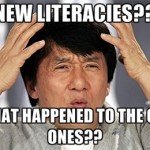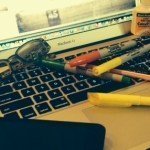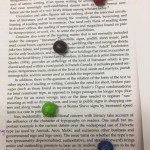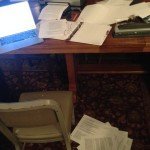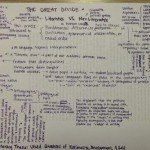Brady Freitas: Curated Blog for Week 2
Hi everyone!
During week 2 in Theories of Literacies, we explored all notions of what is constitutive of literacy by reading Jennifer Roswell and Kate Pahl’s “Introduction” to literacy studies in The Routledge Handbook of Literacy Studies. In essence, literacy is so much more than merely being able to read and write. Roswell and Pahl give a great definition on the expansive, complex, and diverse ways literacy emerges in our lives, for it:
“exists in homes [and many other places] with the varied ways that people live, speak and practice the everyday… Literacy is aesthetic, material and multimodal. Literacy is both local and global, evident in rural as well as in urban settings. Literacy changes with practices, and transmutes across borders, languages and modes. Literacy is digital, immersive and networked. Literacy is felt, sensed and associated with place” (Roswell and Pahl 1).
This is a noticeably longer take on what literacy is in comparison to the one we are used to hearing in grade school as simply the ability to read and write. As you read the definition you might think: “How can literacy be all these things?” “What happened to it just being about reading and writing?”
Thanks to our other reading this week by David Bloome and Judith Greene, “The Social and Linguistic Turns in Studying Language and Literacy,” it works in tandem with Roswell and Pahl’s expansive and frankly overwhelming description, in order to to help us understand the reasons for such a broad take on what constitutes as literacy. These turns in the field of literacy— to the social and linguistic— are the reason why Roswell and Pahl’s definition of literacy can be so wide-ranging.
It is important to understand in what ways these turns reshape our understanding of literacy —one that is aligned with how it is seen by literacy researchers— rather than our pop-cultural consciousness of thinking reading a book and being able to write a letter to your grandma as the things that make you literate, for example. Starting with what Bloome and Greene call an autonomous model of literacy, “the individual employs cognitive and linguistic skills, strategies, and processes that are mostly autonomous of the social context which the reading or writing occurs” (Bloome and Greene 20). Another title for this model of literacy could be the anti-social model, as it merely focuses on reading and writing skills that are outside the social and cultural context in which they occur. This model posits two ideas:
- that literacy is (only) reading and writing
- and that literacy is static in what is constitutive of it (i.e. literacy is not social).
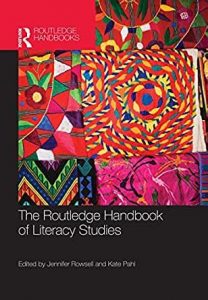 However, with the turn to recognize that language is inherently a social heuristic in which we communicate in our realms, literacy becomes a “non-trivial use of written language” where no matter what, the ways in which we— as humans— do literacy cannot be separated from the idea of what literacy means in that specific context” (Bloome and Greene 20).
However, with the turn to recognize that language is inherently a social heuristic in which we communicate in our realms, literacy becomes a “non-trivial use of written language” where no matter what, the ways in which we— as humans— do literacy cannot be separated from the idea of what literacy means in that specific context” (Bloome and Greene 20).
This calls for a new model of literacy, one that understands the flux and social nature of literacy. The ideological model of literacy, according to Bloome and Greene, fits the social turn by a literacy that
“does not exist as a thing in-and-of-itself. Rather it is the situated, contextualized use of written language by people as they interact with each other within the social institutions and social spaces in which they live their lives. Literacy practices and events are embedded in, and constitutive of cultural ideologies. That is, a cultural ideology informs, and is informed by, what literacy practices are used in what social situations when, by whom, with what meanings, and with what social consequences.”
Similar to how I said you can think of the autonomous model of literacy as anti-social, you can think of this one as the social model of literacy. With that being said, the social turn in literacy allows for a more nuanced and accurate depiction of what literacy is, depending on the socio-historical context in which a certain literacy is taking place. Moreover, before we can turn back to Roswell and Pahl’s wide-ranging definition of literacy: it is still necessary to shift to Bloome and Greene’s explanation of the linguistic turn in literacy studies.
The important thing to remember when it comes to the linguistic turn is the fact that language represents and organizes the social world we live in. This turn allows for the “deconstruction and reconstruction of disciplinary bodies of knowledge,” which allows for a multitude of epistemologies and ontologies to be thought up and considered, hence the fact we see Roswell and Pahl’s definition around what literacy can be, as so expansive-oriented (Bloome and Greene 22). The linguistic turn enables for the expansion of the field, while the social turn allows for literacy studies to continuously adjust and reshape depending on the sociohistorical literacy event.
Therefore, when we turn back to the “Introduction” by Roswell and Pahl, it becomes clear that the spaced-focused, time-focused, multimodal, digital, hermeneutic, everyday, and communal literacy approaches all have a validity within the scope of literacy studies thanks to the social and linguistic turn within the field. When considering all the different approaches and subcategories within literacy studies through the lens of the social and linguistic, it is apparent that this reimagining of what literacy is, is important for a more nuanced, disparate, and accurate understanding of how we become literate beings in the world(s) we live in.
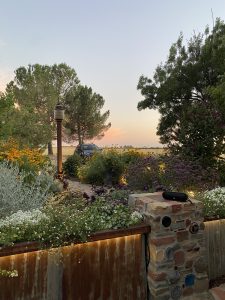 Recursively, the idea that “literacy is felt, sensed, and associated with place,” I begin to understand how place is a crucial component when thinking about literacy (Roswell and Pahl 1). However, a question I am left with from this reading is in what ways do I begin to understand the felt and sensed aspects of literacy? What does this mean exactly?
Recursively, the idea that “literacy is felt, sensed, and associated with place,” I begin to understand how place is a crucial component when thinking about literacy (Roswell and Pahl 1). However, a question I am left with from this reading is in what ways do I begin to understand the felt and sensed aspects of literacy? What does this mean exactly?
During our class session our initial probing question into these readings was “What is the range for what this field [literacy] studies?” Of course after reading Roswell and Pahl’s “Introduction,” I was relatively overwhelmed with the rhizomatic structure that is literacy studies, all connected in some ways via the social and linguistic turn, but all doing vastly different things. This question was one we explored the meaning / answer to throughout our class time together, and one I believe which will shape the rest of the course, in order to gain a deeper sense of what the field studies. Thus, when referring back to the felt and sensed aspects of literacies, it has me thinking that they— like literacy itself— are always changing and influx, which results in me asking what ways do I currently feel and sense literacies in the places I am embedded into?
After talking about the field a little bit we turned to schooled literacy, and ways in which we see the effects of these literacy events and practices shaping our histories of literacy in some ways. One of the largest themes from this discussion is the difficulty of breaking away from schooled literacies. For example, Alondra, a graduate student, explained how she still raises her hand when wanting to say something even though there has been no need / purpose to do this since her days in K-12. We also discussed why memorization is the test of importance on subject competency. Larisa mentioned how even in her high school English classes, which are notoriously known as a place for critical thinking and exchange of ideas through socratic seminars / fishbowls, there was still the need for supposed reading comprehension with tests on novels. Having a test based upon memorization of the novel’s material seems strange and foreign if given one in a college-level literature class. A hard question to answer as to why memorization is so important in K-12 education, but one reason that made sense (I forget who mentioned it, the irony) was the fact that standardized tests like the SAT and ACT were the determiners in getting into prestigious institutions after high school.
Kim brought up a great question in class, which was “for those of you who are teaching English 130W [Academic Writing aka FYC] this semester, what do your students think they are doing in regard to writing, and are they learning about different disciplines / discourse communities?” As someone who is teaching English 130W this semester, I began to think about the literacy practices I was asking of students, while also questioning the literacy event that I was constructing in my classroom. We moved on from this question relatively quickly, into related topics of students (personal) needs, and ways we can support students in coming to class and doing the work. However, when thinking back to Kim’s question it is one that I am interested in exploring for the entirety of the semester and beyond, as the classroom is an important place in which instructors can deconstruct certain K-12 sensibilities, while giving students opportunities to understand and operate in college settings both materially and in designated discourse communities. With that being said, one other thing that Kim mentioned that resonated, is the fact that there should not be a first-year composition course, at least the way we have it structured now. If we are asking students to write in certain discourse communities for their majors, why the hell are we not teaching them that?
After discussing our relationship with literacy and our schooling— something that is hard to think outside of, as it is so interconnected to our socio-historical moment— we turned to mapping our own histories of literacy. Some fellow classmates shared books, professors, and classes they took, while others shared video games they played growing up. A challenging task to rhizomatically connect your literacy practices to one another throughout your life, I initially began thinking about my time in graduate school and working backwards from there. I was hoping to eventually get to other literacy practices and events that were present when I was a kid, however, I began to think too closely on the literacy practices I have gained while in college solely. Perhaps in the future, breaking up my literacy practices by place, will help me focus and hone in on certain literacies throughout my life.
From this week’s readings and class discussion I am left with the following questions, including the ones I have bolded in my blog post above:
- In what ways are my literacy practices being changed as I progress through this course? Do I feel I have gained a more keen cognizance of what my own literacy practices are (by the end of the semester)?
- What do you teach when it comes to literacies (for all of us who are or want to teach in the future)?
- How can we create effective heuristics to help us operate in certain places, spaces, and literacy events?
- What literacies count and which ones do we disregard? Why? And in what ways can we ensure justice for disparate, diverse, and different literacies than ones that hold hegemony in our current position in the space-and-time continuum?
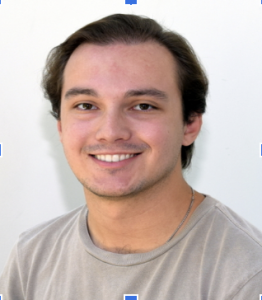 Author’s bio: Brady Freitas is an English graduate student at Chico State. His research interests include spatial and geographic rhetorics, place-based pedagogy, and practices of the everyday. He currently teaches first-year composition, with hopes to continue his passion for teaching in the future. In his free time, he likes to spend time outdoors, hanging with his dogs, and going to Whiskeytown Lake.
Author’s bio: Brady Freitas is an English graduate student at Chico State. His research interests include spatial and geographic rhetorics, place-based pedagogy, and practices of the everyday. He currently teaches first-year composition, with hopes to continue his passion for teaching in the future. In his free time, he likes to spend time outdoors, hanging with his dogs, and going to Whiskeytown Lake.
